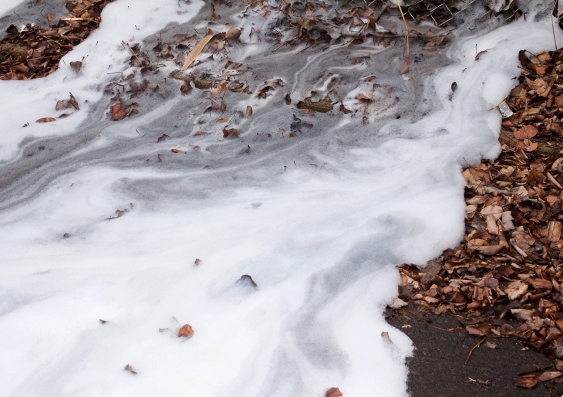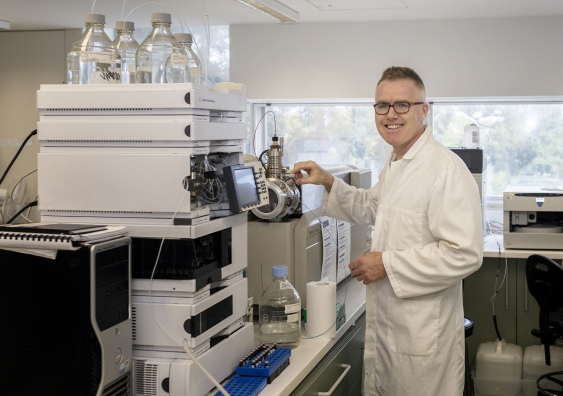WeÔÇÖre likely underestimating the future impact of PFAS in the environment, a new ╣·▓·¥½ãÀ Sydney-led study shows.
Per-and poly-fluoroalkyl substances ÔÇô commonly known as PFAS ÔÇô are a group of over 14,000 human-made chemicals that have been popular since the 1950s for their diverse uses in resisting heat, water, grease and stains.┬á┬á
TheyÔÇÖve been commonly found in household products like non-stick frying pans, clothing, cosmetics, insecticides, and food packaging, as well as specialty industry products, like firefighting foam.┬á
But despite their broad skillset, the chemicals have a dark side: theyÔÇÖre known as ÔÇÿforever chemicalsÔÇÖ because once theyÔÇÖre in the environment ÔÇô or our bodies ÔÇô they donÔÇÖt degrade further.┬á┬á
PFAS have been linked to environmental and health issues, including some cancers, but a lot remains unknown about the true scale and potential impacts of the problem ÔÇô including how much is in our water supply.┬á
A new ╣·▓·¥½ãÀ-led international study, published today in , assessed the levels of PFAS contamination in surface and ground water around the globe.┬á┬á
It found that much of our global source water exceeds PFAS safe drinking limits. 
ÔÇ£Many of our source waters are above PFAS regulatory limits,ÔÇØ says senior author of the study, ╣·▓·¥½ãÀ Engineering Professor Denis OÔÇÖCarroll.┬á
ÔÇ£We already knew that PFAS is pervasive in the environment, but I was surprised to find out the large fraction of source waters that are above drinking water advisory recommendations,ÔÇØ he says.
ÔÇ£We're talking above 5 per cent, and it goes over 50 per cent in some cases.ÔÇØ┬á
Media enquiries
For enquiries about this story and to arrange interviews, please contact Jacob Gillard.
▒╩│¾┤Ã▓È▒:╠²+61 2 9348 2511
Email: jacob.gillard@unsw.edu.au
The research team pulled together PFAS measurements from sources around the world, including government reports, databases, and peer-reviewed literature. Altogether, they collated more than 45,000 data points, which span roughly 20 years.  
ItÔÇÖs the first study to quantify the environmental burden of PFAS on a global scale.
The study also found high concentrations of PFAS in Australia, with many locations above recommended drinking water levels. This tended to be in areas where firefighting foams had been used in the past, such as military institutions and fire training facilities.  
Prof. OÔÇÖCarroll stresses that these PFAS traces are found in source water, such as dams, and not drinking water itself ÔÇô drinking water goes through treatment plants, some of which are designed to reduce the amount of chemicals such as PFAS in our water before it comes out of the tap. ┬á
But some water providers ÔÇô for example, Sydney Water ÔÇô donÔÇÖt routinely measure the broad range of PFAS potentially in our drinking water, says Prof. OÔÇÖCarroll.
ÔÇ£Drinking water is largely safe, and I don't hesitate drinking it,ÔÇØ he says. ÔÇ£I also donÔÇÖt suggest that bottled water is better, because it doesnÔÇÖt mean that theyÔÇÖve done anything differently than what comes out of the tap.
ÔÇ£But I certainly think that monitoring PFAS levels and making the data easily available is worthwhile.ÔÇØ
A contentious debate: how much PFAS is too much?
Most people in Australia ÔÇô and in many places around the world ÔÇô are likely to have low levels of PFAS in their bodies.┬á
But the potential health risks of PFAS chemicals are poorly understood and havenÔÇÖt been agreed on universally.┬á
According to an Australian Government expert health panel, there is ÔÇô although further afield, peak bodies in the and suggest that PFAS is linked to adverse health outcomes, such as lower birth weight in babies, higher levels of cholesterol, reduced kidney function, thyroid disease, altered sexÔÇ»hormone levels, reduced vaccine response, and liver, kidney, and testicular cancers.
In 2023, the World Health Organisation (WHO) declared PFOA, a type of PFAS, a category one human carcinogen. 
While PFAS has been linked to many of these health outcomes, they havenÔÇÖt necessarily been shown to cause them ÔÇô but given the potential risks and ÔÇÿforeverÔÇÖ nature of these chemicals, many regulatory bodies have tightened PFAS use and introduced safe drinking water limits as a precaution.
ÔÇ£Two forms of PFAS initially raised of concerns about 20 years ago: PFOS and PFOA,ÔÇØ says Prof. OÔÇÖCarroll.┬á
ÔÇ£These chemicals are regulated to different extents around the world. In the US, the proposed drinking water limits for PFOS and PFOA are four nanograms per litre.ÔÇØ
A third PFAS is also regulated in Australia, called PFHxS. Here, the sum of PFOS and PFHxS is limited to 70 nanograms per litre ÔÇô well above the four nanograms per litre combined PFOS and PFOA limit in the US.┬á
But our acceptable levels for PFOA in drinking water is even higher. 
ÔÇ£PFOA, on the other hand, is regulated in Australia at 560 nanograms per litre, which is two orders of magnitude higher than in the US,ÔÇØ says Prof. OÔÇÖCarroll.┬á
WeÔÇÖre likely underestimating the environmental burden posed by PFAS.
While AustraliaÔÇÖs limits seem relaxed compared to the US, both countriesÔÇÖ recommended drinking water guidelines pale when compared to CanadaÔÇÖs: here, rather than limiting only two or three forms of PFAS in drinking water, Canada tallies up the sum of all 14,000 PFAS and limits the overall number to 30 nanograms per litre.
The study found that 69 per cent of global groundwater samples with no known contamination source exceeded Health CanadaÔÇÖs safe drinking water criteria, while 32 per cent of the same samples exceeded the USÔÇÖs proposed drinking water hazard index.┬á
ÔÇ£ThereÔÇÖs debate about what level PFAS should be regulated to,ÔÇØ says Prof. OÔÇÖCarroll. ÔÇ£Australia has much higher limits than the US, but the question is why.
ÔÇ£Both health bodies would have different reasoning for that, and thereÔÇÖs not a really strong consensus here.ÔÇØ┬á
An underestimated risk
The study suggests that actual PFAS pollution in global water resources could be higher than suspected. 
This is, in part, due to us only monitoring and regulating a limited number of the 14,000 PFAS in existence, and also because the levels of PFAS in consumer products are higher than expected.
ÔÇ£ThereÔÇÖs a real unknown amount of PFAS that weÔÇÖre not measuring in the environment,ÔÇØ says Prof. OÔÇÖCarroll. ÔÇ£Commercial products like garments and food packaging have a lot more PFAS in them than we realise.┬á┬á
ÔÇ£This means weÔÇÖre likely underestimating the environmental burden posed by PFAS.ÔÇØ
Prof. OÔÇÖCarroll and his team are now trying to develop their research by quantifying these levels of PFAS from commercial products in the environment.┬á┬á
TheyÔÇÖre also working to develop technologies that can degrade PFAS in drinking water systems, and looking at developing predictive models that determine where PFAS will go in the environment.
ÔÇ£Part of this is figuring out how PFAS will associate with different parts of the environment and our bodies ÔÇô proteins, for example,ÔÇØ says Prof. OÔÇÖCarroll.┬á
These studies will be in progress over the next two years and aim to be completed by 2026.
In the meantime, Prof. OÔÇÖCarroll says manufacturers and consumers alike need to be careful and do our due diligence when using products containing PFAS.┬á
ÔÇ£We manufacture and distribute a lot of chemicals without having a full assessment on their potential health impacts,ÔÇØ he says.
ÔÇ£We should have judicious use of some of these chemicals. Just because theyÔÇÖre available, doesn't mean that we should use them.ÔÇØ








